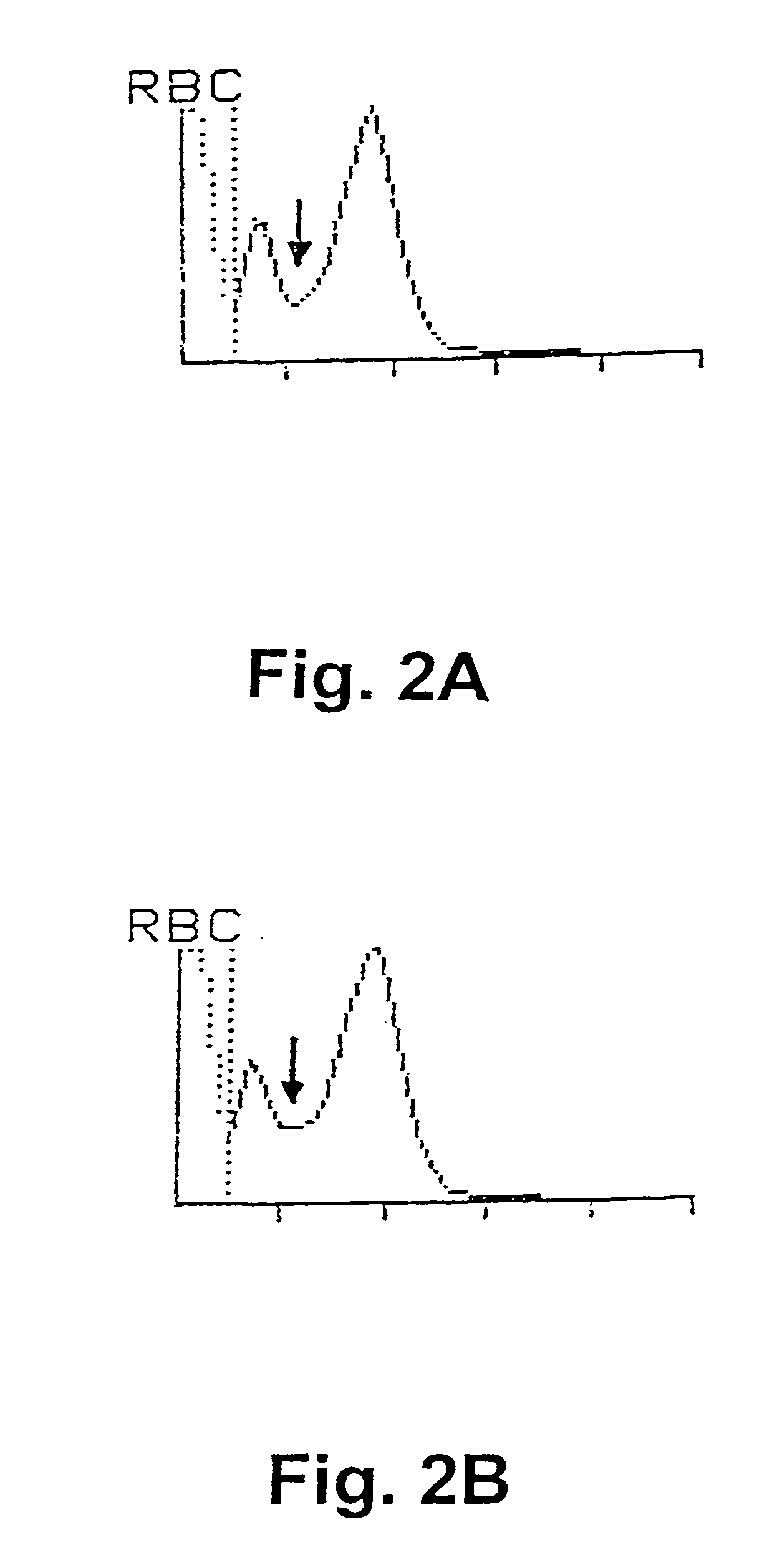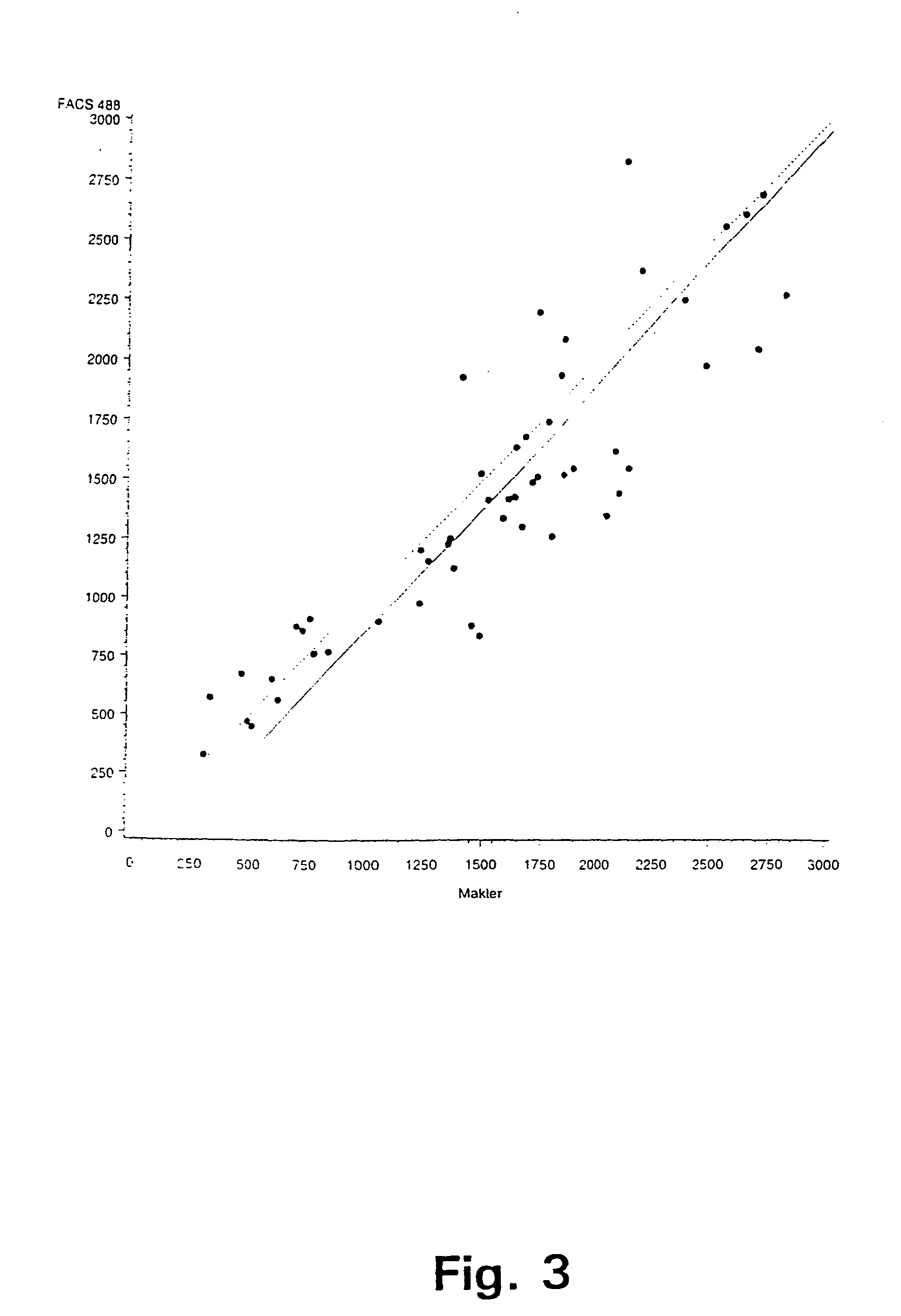Determination of sperm concentration and viability for artificial insemination
a technology of artificial insemination and sperm concentration, applied in the direction of dead animal preservation, measurement devices, instruments, etc., can solve the problems of slow use of counting chambers, insufficient accuracy of single hemacytometer counts, and time-consuming procedures
- Summary
- Abstract
- Description
- Claims
- Application Information
AI Technical Summary
Benefits of technology
Problems solved by technology
Method used
Image
Examples
experiment 1
SUMMARY
[0063]In a first experiment, sperm concentration and viability in bull ejaculates have been determined by selective staining of the live and dead sperm cells in a semen sample and subsequently, analysing the semen samples with flow cytometry according to a preferred embodiment of the invention. For comparison purposes, the sperm concentration has also been determined using prior art methods, i.e. by determination of sperm concentration with a spectrophotometer (L'Aiglon, IMV, Cedex, France) and a particle counter (Sysmex F-820, SYSMEX, Almind, Denmark), and further using manual counting using a Makler chamber (Sefi Medical, Haifa, Israel) and a phase contrast microscope.
[0064]The analyses using flow cytometry for simultaneous determination of sperm concentration and viability in bull ejaculates at AI station were carried out using two different FACSCount flow cytometers (BDIS Europe, Erembodegem-Aalst, Belgium) equipped with a blue (488 nm), and a green (543 nm) laser, respec...
experiment 2
SUMMARY
[0102]In a second experiment, sperm concentration and viability in boar ejaculates have been determined according to a preferred embodiment of the present invention. Live and dead sperm cells in boar semen samples have been stained selectively, and subsequently the semen samples have been analysed with FACSCount flow cytometers equipped with either a 488 nm or a 543 nm laser. A total of 58 ejaculates was analysed on each of the two flow cytometers and on a spectrophotometer (Corning 254). Furthermore, the sperm were counted in a Thoma haemacytometer using phase contrast microscopy at 200× magnification.
[0103]The results of this experiment show that determination of sperm concentration with the two flow cytometric techniques results in a higher precision and accuracy than obtained with the Corning 254 spectrophotometer. Gel-particles, present in large number in boar semen, increase the turbidity of boar semen and make spectrophotometric measurements unreliable. It is a signifi...
experiment 3
SUMMARY
[0112]An important application of the flow cytometric methods described above is the possibility to predict the fertility according to the predetermined sperm concentration and sperm viability. To assess the value of this technique for the selection of semen samples for artificial insemination (AI), a large scale fertility trial with bull semen have been performed. In the present experiment there has been used SYBR-14 in a concentration of 50 nM and PI in a concentration of 12 μM. Four ejaculates from each of 157 bulls (Holstein or Jersey breeds) have been analyzed fresh and frozen-thawed using flow cytometric methods and computer assisted sperm analysis (CASA). Furthermore, the fresh semen was subjected to morphological evaluation of the semen, and standard routine evaluation of the semen samples were carried out in the involved bull stations. A total of 121.232 inseminations with insemination doses provided from the 4×157 ejaculates were performed in Danish cattle herds. Pr...
PUM
 Login to View More
Login to View More Abstract
Description
Claims
Application Information
 Login to View More
Login to View More - R&D
- Intellectual Property
- Life Sciences
- Materials
- Tech Scout
- Unparalleled Data Quality
- Higher Quality Content
- 60% Fewer Hallucinations
Browse by: Latest US Patents, China's latest patents, Technical Efficacy Thesaurus, Application Domain, Technology Topic, Popular Technical Reports.
© 2025 PatSnap. All rights reserved.Legal|Privacy policy|Modern Slavery Act Transparency Statement|Sitemap|About US| Contact US: help@patsnap.com



